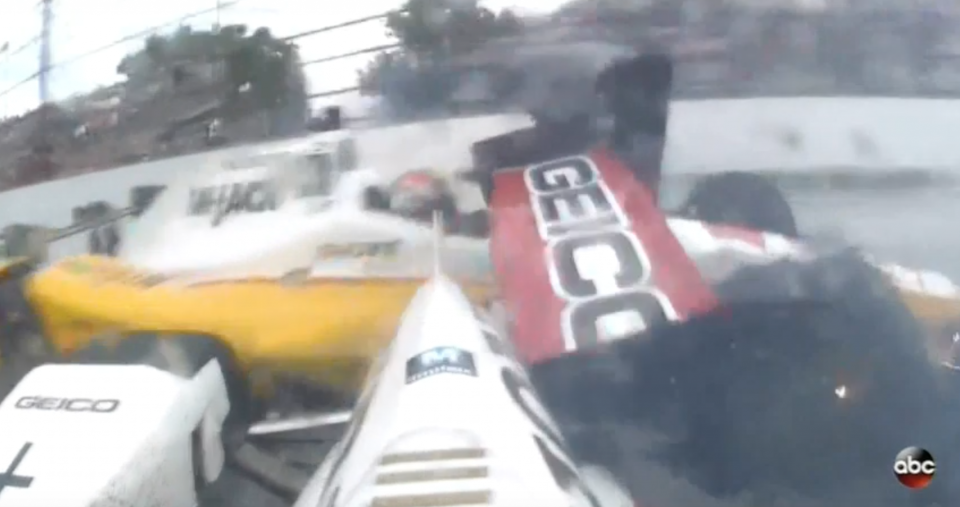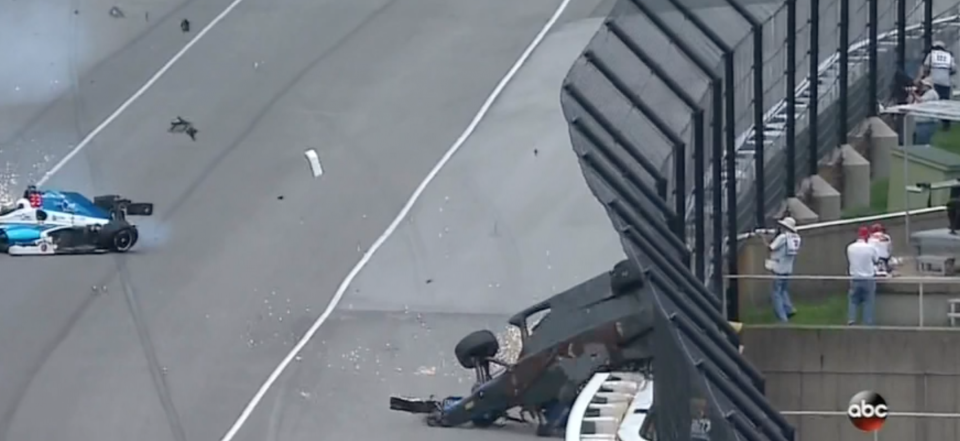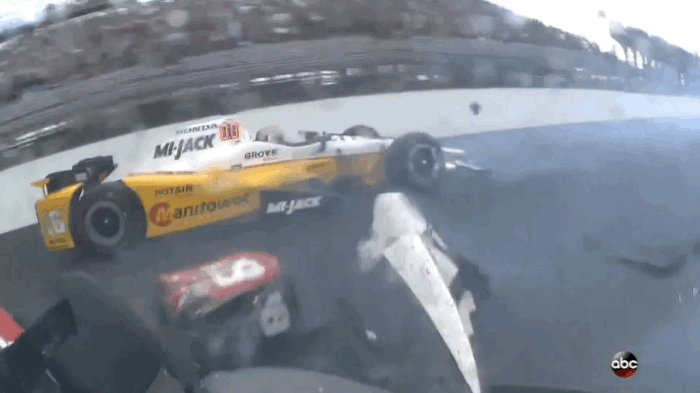After scary Indianapolis 500 incidents, IndyCar has to stop having open cockpits immediately

There’s no better time than now for the IndyCar Series to find a better way to shield its drivers’ heads.
The safety advances IndyCar has made over the last 20 years were on full display during Sunday’s Indianapolis 500 won by Takuma Sato. Scott Dixon and Jay Howard were able to walk away from a terrifying incident where Dixon’s car catapulted over the top of Howard’s and landed on a wall.
No driver was hurt in a five-car pileup inside the race’s final 20 laps that started when James Davison and Oriol Servia made contact. And Buddy Lazier hit a wall with styrofoam padding in the middle when his car snapped around in turn 2 and made violent contact with the outside wall.
IndyCar can point to all three incidents as moments of safety pride. But each and every one could have been much, much worse had they unfolded slightly differently and a driver’s head sustained a direct impact with car parts or the wall.
The last two driver deaths in the IndyCar Series have come as a result of head injuries. Dan Wheldon was killed in 2011 when his car flew into the catchfence and his head hit a metal pole in turns 1 and 2 at Las Vegas Motor Speedway.
In 2015, Justin Wilson died after sustaining a serious head injury when his helmet was hit by a piece of debris from a wrecked car ahead of him at Pocono.
Both Wheldon and Wilson would have had far greater chances of survival had their heads not been exposed in the open-cockpit design that IndyCar has always employed. Each incident sparked discussion about solutions to protect drivers’ heads, but nothing came close to implementation.
Standing pat wasn’t acceptable after Wheldon and Wilson’s deaths and it still isn’t so now. While the series basks in the pride of an Indianapolis 500 with no serious driver injuries, IndyCar needs to take immediate action and find an enclosed cockpit solution for its cars as soon as possible.
The hypotheticals surrounding Dixon’s accident are the most dramatic evidence supporting an enclosed-cockpit solution. As Dixon’s car tumbled through the air it landed on its side on top of the turn 2 inside wall so violently that the engine was separated from the chassis Dixon occupied.
Oh my god it’s incredible that Scott Dixon is OK. pic.twitter.com/2nA1DRIIRo
— Nick Bromberg (@NickBromberg) May 28, 2017
Had the rotation of Dixon’s car been just fractionally quicker, the roof of his car could have landed on the top of the wall, exposing his helmet to the concrete.

Lazier’s crash wasn’t nearly as visually terrifying as Dixon’s. His car snapped loose in turn 2 and smashed into the SAFER barrier on the outside of turn 2. SAFER — a wall with styrofoam blocks in the middle of two concrete and steel barriers, helps absorb energy from a crash and was first introduced at Indianapolis Motor Speedway.
It’s undoubtedly saved many drivers from greater injury and likely limited Sebastien Bourdais to pelvic fractures and a hip fracture in his awful high-speed crash in 500 qualifying last week.
As Lazier’s car slid into the wall it created a field of debris for the cars behind him to navigate. The debris is a sign that the car is dissipating energy — a good thing for Lazier, who was taken to the hospital as a precaution because of pains in his chest area.
But that debris field creates a danger zone for the drivers behind the accident no matter how light the carbon fiber pieces that fly off the car really are. At 200 MPH, a fly can feel like a BB. Thankfully, none of the bouncing pieces of debris from Lazier’s car (that we know of) hit a driver in the helmet.
No one flipped over or went flying through the air in the five car crash instigated by contact between Davison and Servia. But a moment in the aftermath as Davison and Servia’s cars were sliding to a stop was just as vivid a reminder of the head dangers that IndyCar drivers face as Dixon’s crash was.
As Davison and Servia slid towards turn 2, the rear wing was ripped off of Davison’s car and sticking out at an angle. When Davison’s car approached Servia’s again near the outside wall, the protruding piece came within inches of hitting Servia square in the helmet.

The open-cockpit design has lasted as long as it has largely because of tradition. After 101 Indianapolis 500s without cars with a roof, a 102nd Indy 500 with cars featuring roofs would be a stark departure.
Other concerns include driver visibility. After years and years of driving without an enclosure, it would take a serious adjustment for many drivers. There are also worries about safety side effects. Could a driver effectively get out of a car that was on fire?
While the reasons listed above have at least a tiny sliver of merit to each, they’re all overridden by the practicality of a closed cockpit solution. Many traditions have proven to be ineffective as time marches on. Yeah, there’d be an adjustment, but drivers would quickly get used to closed cockpits.
And the IndyCar safety team is the best in North American motorsports. It was to Bourdais’ car 11 seconds after his qualifying accident. Its excellence diminishes the concerns like fire and overturned cars at the expense of blunt head trauma.
The current Dallara chassis — the DW12 named after Wheldon — is being discontinued at the end of the season in favor of a newer, sleeker car in 2018. That car, revealed earlier this spring, continues to have a traditional open-cockpit design.
While a canopy or some sort of shield shouldn’t wait until next season to make its debut, there’s still plenty of time for IndyCar and Dallara to find a closed-cockpit solution for its new car. Even as IndyCar continues to make great steps in the name of safety, it’s never going to go as far as it could to keep its drivers safe without finding a solution for its current cockpit design.
– – – – – – –
Nick Bromberg is the editor of Dr. Saturday and From the Marbles on Yahoo Sports. Have a tip? Email him at nickbromberg@yahoo.com or follow him on Twitter!

 Yahoo Sports
Yahoo Sports 

